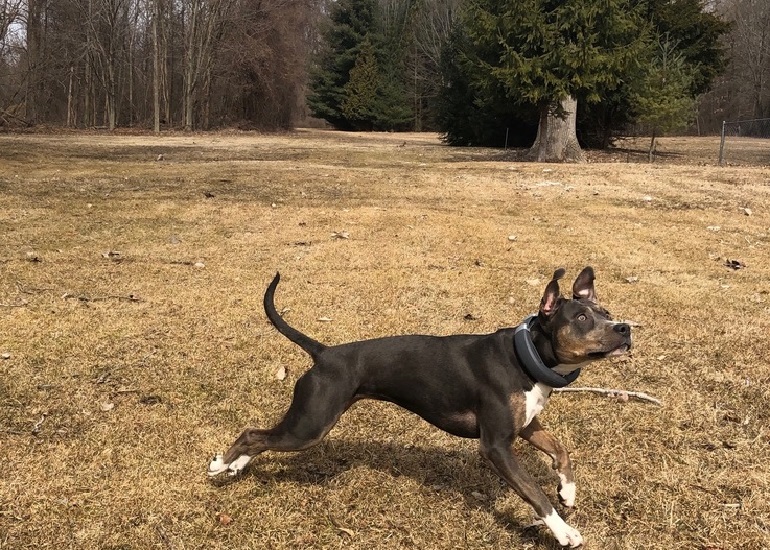As a loving dog owner, you understand the importance of keeping your furry friend safe and secure. That’s where the Halo Wireless Dog Fence comes in. Unlike traditional physical and electric fences that have gaps in coverage and may pose safety risks, the Halo Wireless Dog Fence is a virtual fence that uses advanced technologies to keep your pet within a specified boundary, making it the ideal solution for an active lifestyle.
The Halo Wireless Dog Fence system features a smart collar and an activity tracker that uses location services to ensure your dog stays within the designated area. Additionally, the subscription plans offered by Halo Wireless Dog Fence provide exclusive videos and training programs, making it easier to train your dog to respect the virtual boundary.
What is a Wireless Dog Fence?
A wireless dog fence is a system that uses a boundary training approach to keep your dog safe and secure within a designated area without the need for a physical fence. Instead, the system utilizes a collar worn by your dog, which communicates with a transmitter base station installed in your home or yard. As your dog approaches the virtual boundary, the collar emits a warning sound, followed by a static correction if they cross the boundary. In this way, a wireless dog fence provides a humane and effective solution to keep your furry friend secure while giving them space to roam freely.
Benefits of Halo Wireless Dog Fence
Halo Wireless Dog Fence is an innovative and effective solution to keep your furry friend safe and secure. Unlike traditional fences, this smart collar offers unmatched convenience, adaptability, and unique features for the best protection of your dog.
One of the most significant benefits of the Halo Wireless Dog Fence is its flexibility and adaptability. If you love to take your furry friend on outdoor adventures, then Halo is the ideal solution for you. Its wireless design provides a wide range of sound alerts that teach your dog the boundaries of your property and keep them safe, whether you are at home or on-the-go.
Another highlight is Halo’s rechargeable and water-resistant collar. In contrast to shock collars, which require battery replacement, the rechargeable feature saves you time and money. Plus, the water-resistant feature ensures that it works even if your dog loves jumping into the pool or playing in the rain.
Additionally, Halo Wireless Dog Fence comes with other unique features that set it apart from other wireless dog fences on the market. Its static correction is customizable to suit your dog’s learning style, allowing for a more humane way to train your beloved pet. The fence also offers activity tracking and nighttime visibility, ensuring that your pet is healthy and safe.
Training Your Dog to Use the Halo Wireless Dog Fence System
Training your dog to use the Halo Wireless Dog Fence System is an essential part of keeping your furry friend safe while giving them the freedom to explore your outdoor space. With the help of advanced technologies and customizable settings, teaching your dog the boundaries of your property has never been easier.
Here’s a step-by-step guide on how to train your dog to use the Halo Wireless Dog Fence System.
Types of Training Techniques Used with the Halo System
The Halo wireless dog fence can provide a secure option for pet owners. However, it’s important to experiment with different training methods to find the best fit for your dog’s learning style. But, in order to train your dog to stay within the boundary, it’s essential to try out different techniques to determine which one is suitable for your dog’s learning style. Here are some types of training techniques used with the Halo system:
1. Boundary Training – This technique involves the use of positive association to help your dog identify the boundary. It’s important to set up the boundary flags so that your dog can see where the boundary lies. The static correction delivered by the collar also provides feedback that helps your dog learn to avoid going outside of the designated area.
2. Indoor Training – For pet owners who want to keep their dogs within their homes’ confines, this training technique can be used. By setting up the system inside and walking your dog around the perimeter, they can begin to learn where the boundary lies. Just like with outdoor training, the collar delivers static correction as feedback to help your dog learn.
3. Outdoor Training – This training technique is more practical for pet owners who want to use the Halo system to keep their dogs within their yards. As with indoor training, you can walk your pet around the boundary line and wait for the collar to deliver static correction as they approach the boundary.
4. Positive Reinforcement – Using positive reinforcement can help your dog learn quicker and more effectively. This method involves offering praise or treats for staying within the boundary, thereby encouraging your dog to keep doing so.
5. Static Correction – The Halo system is designed with proprietary static correction technology created to get your dog’s attention when they approach the boundary. The benefit of this technique is that the static correction is customizable and can be adjusted to suit your dog’s individual temperament.
Boundary Training Basics
When it comes to keeping your dog safe and secure in your yard, a traditional fence may not always be an option. That’s where the Halo Wireless Dog Fence system comes in, providing a virtual boundary that keeps your furry friend from straying too far from home. But, it’s essential to understand that proper training is necessary to ensure your dog’s safety and comprehension of the virtual boundaries.
Boundary training with the Halo Wireless Dog Fence system involves using various techniques to teach your dog to identify and stay within the virtual fence area. One such technique is the Perfect Start Plus Training Protocol, designed to enhance the effectiveness of the system’s virtual boundaries.
To achieve successful boundary training, follow these necessary steps:
1. Set up the virtual fence: Start by setting up the virtual boundary flags and testing the system’s signal strength. This will give you a clear understanding of where your dog can and cannot go.
2. Gradually introduce your dog to the fence: Slowly introduce your dog to the virtual fence by walking them around the area, providing positive feedback, and rewarding them for staying within the boundaries. It’s essential to repeat this process multiple times to ensure your dog is comfortable.
3. Reinforce positive behavior: As your dog becomes more comfortable with the virtual boundaries, continue to reinforce positive behavior by giving praise, treats, and rewards. This positive reinforcement helps your dog learn to identify and respect the virtual fence’s boundaries and ensures they do not leave the designated area.
By following these steps, you can use the Halo Wireless Dog Fence system to create a secure virtual boundary for your furry friend. With practice and proper training, your dog will understand the system’s virtual boundaries and stay safe within your yard.
Static Correction Overview and Safety Guidelines
Static correction is a common technique used in dog training and is often used in conjunction with wireless dog fences, such as the Halo Wireless Dog Fence system, to keep your furry friend within the designated boundaries. This type of correction involves a small static charge that is emitted through a collar worn by your dog when they approach or cross the virtual fence. While static correction can be an effective method, it is essential to use it with caution and follow proper safety guidelines.
Halo’s wireless dog fence system has different levels of static correction intensity, ranging from low to high, which can be adjusted according to your dog’s size and temperament. It’s crucial to introduce the collar gradually and use the lowest intensity level first. The goal is to discourage boundary violations and reinforce the virtual fence’s boundaries gently.
It’s important to use static correction sparingly and only when necessary. If your dog has trouble learning to respect the virtual fence boundaries, you can gradually increase the correction level, but only one level at a time. Always wait for at least one week before adjusting the level again. If increasing the correction level does not work, it may be time to reassess your dog’s training and seek professional help.
To avoid injuries and ensure that the static correction is used safely, it’s important to read the manufacturer’s safety guidelines thoroughly. Avoid using the collar on puppies younger than six months, dogs weighing less than eight pounds, or dogs that are in poor health or have skin sensitivities. Always check the collar fit, skin irritation, and discomfort to prevent injuries or discomfort.
Halo’s wireless dog fence system employs minimal static correction and emphasizes positive reinforcement training methods instead. The system is designed to keep your dog safe and secure while allowing them to roam freely within the designated boundaries. It’s essential to approach boundary training and static correction with care, following safety guidelines, and prioritizing positive training methods.
Steps for Effective Boundary Training with the Halo System
Halo Wireless Dog Fence system has recently launched an innovative Halo Training Program, in collaboration with Cesar Millan. This program aims to help fur-parents train their dogs to respect boundaries and keep them safe and secure. Here are the step-by-step guidelines to ensure effective boundary training with the Halo system.
1. Introduce the Halo Training Program and Familiarize your Dog with the Halo Collar: Start by registering for the Halo Training Program and follow the guidelines provided in the training materials. Begin by familiarizing your dog with the Halo collar, as it’s an essential part of the system. First, let your dog wear the collar indoors for a few days, ensuring that they are comfortable wearing it. Next, introduce the collar outdoors and attach the leash to it during walks.
2. Customize the Feedback: The Halo Collar has six different types of feedback, including sound, vibration, static, GPS, boundary flags, and halo light. You can customize these feedback types according to your dog’s learning style and personality. For example, use the sound or vibration feedback for dogs that respond better to audio cues, while static feedback works well for more stubborn dogs. Use GPS feedback primarily for tracking and location services.
3. Establish the Boundaries: You can set up the boundaries using the collar or the app. To set up boundaries using the collar, walk around the perimeter of the area, and the collar will record the GPS location to create a virtual boundary. You can also use the app to set up the boundaries manually. Ensure that the boundaries are far away from physical barriers such as roads or foreign objects, to guarantee the safety of your dog.
4. Train your Dog to Respect Boundaries: Once you have set up the boundaries, you can start the training process. Start by identifying the boundary flags and ensuring that your dog is familiar with them. Use positive reinforcement training methods to reinforce obedience and discourage boundary violations. Let your dog learn by introducing them gradually to the different levels of correction. Use static correction as a last resort only after trying the other feedback methods, and gradually increase only one level at a time.
5. Follow Safety Guidelines: It’s essential to follow safety guidelines provided by Halo, which includes not using the collar on puppies under six months, dogs weighing less than eight pounds, or dogs with skin sensitivities. Always check the collar no more than once every 12 hours, and make sure your dog has a break from the collar 12-18 hours a day to prevent skin irritation and discomfort.
Boundary training with the Halo Wireless Dog Fence system requires patience, diligence, and commitment. By following these step-by-step guidelines, you can ensure that your dog is safely trained to respect boundaries and remains secure within the designated area.
Conclusion
The Halo Wireless Dog Fence is a suitable option for pet owners seeking to secure their dogs without the need for a physical fence. The system offers several advantages, including personalized feedback, effortless boundary setup, and virtual boundary monitoring. However, there are some drawbacks to consider, such as the need for a monthly subscription or cellular service. Based on the information, we highly recommend purchasing the Halo Wireless Dog Fence if you’re looking for a smart solution to keep your pets safe and within the boundaries.



